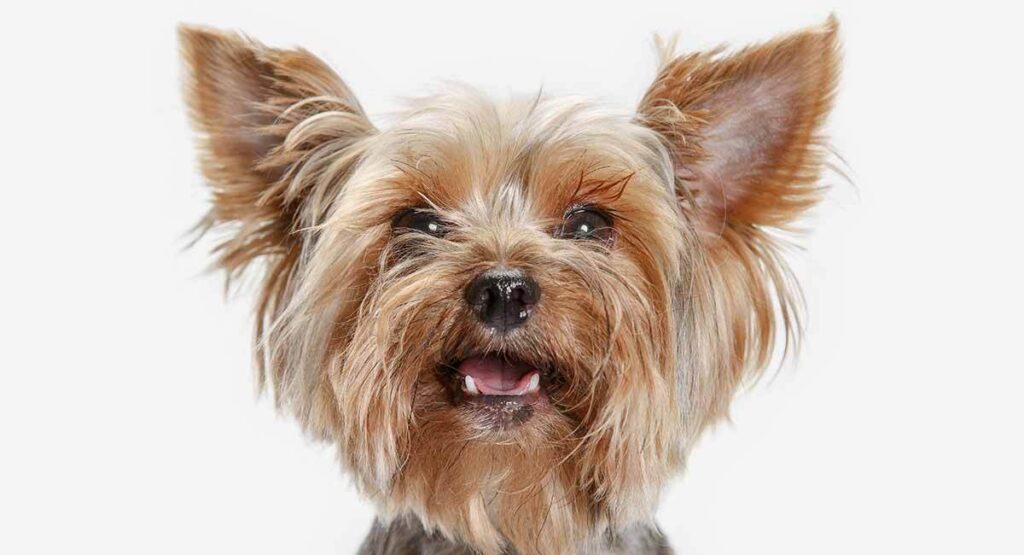
In a world of ever evolving dog breeds, the Yorkie is a constant. Fairly unchanged by the show ring or fashions, they are the same active, independent characters now that they were when I was young. Their hairstyles might range a lot, and of course there is the controversial teacup lines, but your standard Yorkshire Terrier is a healthy, confident companion. They have a medium muzzle, compact body and furry tail. They also have the stubborn terrier streak, and chase instincts from their past as a pest exterminator.
Contents
- A fascinating history
- Coats, colors, grooming and shedding
- Are they good pets?
- Yorkie breeders, puppies and adoption
The Yorkie has long silky hair, in black and tan or parti colors. A toy dog, they weigh between 5 and 7 pounds, and stand 6 to 9 inches tall. Yorkshire Terriers make excellent companion dogs, apartment pets and lap dogs provided they have the exercise they need. A comparatively easy pet dog, they are a good choice for new puppy owners and families with kids too. Yorkies need a home where someone is in most of the time to give them attention as they are prone to separation anxiety. But in the right set up, they can make playful, energetic, loving pets.
Where Do Yorkies Come From?
The Yorkshire Terrier was previously known as the Broken Haired Scotch Terrier and was first seen in England in the mid-1800s. In the late 1800s, the name Yorkshire Terrier came about. The exact origins of the tiny but tough little Yorkie are a source of speculation. Many believe that the first versions of this dog started with Scottish laborers that migrated to England.
The breed has a history as a pest exterminator in 19th Century English factories. They were tiny enough to get into the nooks and crannies chasing after vermin.
In 1865 one particular Yorkshire Terrier, called Huddersfield Ben, was born. He was so successful in the show ring and the ratting ring that he was put to stud. He sired many pups and is considered the foundation of the breed we know today.
The popularity of the dog took off after the UK Kennel Club recognized the Yorkshire Terrier as an official breed. They went from a working dog to a canine companion. And they graced the laps of many Victorian-era ladies.
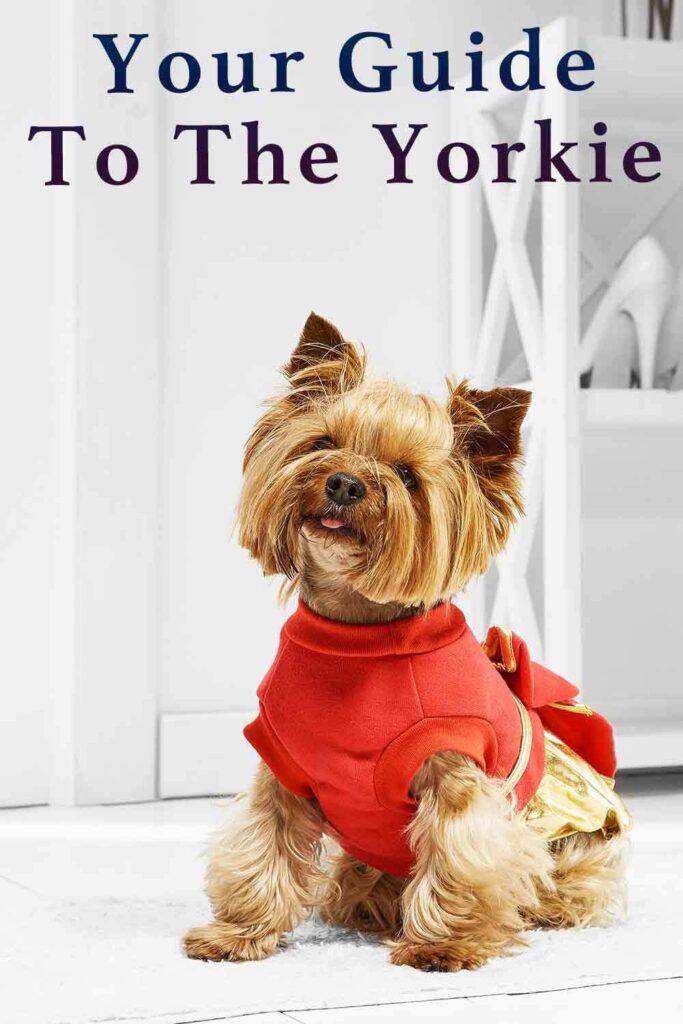
Yorkie Appearance
The Yorkie is a small and evenly proportioned dog with a luxurious coat of hair. This breed certainly stands out in a crowd. Their color is described as dark-steel-blue across their back. When you collect your puppy, this dark blue coloration will look almost black. Yorkshire Terriers are tan on their face and chest. They may not reach its adult hue until as late as three years old. Some Yorkies can even have parti coloring.
However, this beautiful, flowing hair can tangle and break easily. Their coat needs almost as much care and maintenance as human hair because their hair is so similar to.
Coats, Grooming and Haircuts
A Yorkie’s long coat should be brushed every day, but it is not advisable to brush their long hair against a carpeted floor. Yorkies should be bathed weekly, and It is advised to start these grooming routines early on with your puppy so that they are familiar and tolerant of them.
Yorkshire Terrier fur is normally styled and given a neat center parting from head to tail in the show ring. The hair on the top of their heads is held up and away from their eyes often with a clip or bow. This styling prevents their vision from being impeded and also gives them the required look.
When their coat is worn long, great care needs to be taken to keep it looking both silky and straight Some owners will even apply coat oil and wrap the hair to prevent breakages. For pet owners, a slightly shorter cut or all over clip will be a lot more practical and minimize your time spent on grooming. This breed is well served with regular trips to the groomers.
Are Yorkies Hypoallergenic?
As mentioned earlier, Yorkies have long coats with a similar texture to that of human hair. It’s important to make sure it is well managed. If neglected, their silky hair can get matted and tangled. It can also break easily. We will touch more on Yorkie grooming and coat care later.
Yorkshire Terriers do not shed a huge amount, as long as their fur is well looked after. But, no dog breed is 100% hypoallergenic. If you suffer from dog allergies, there is still a chance that you will be allergic to a Yorkie. Spend some time with a puppy before bringing them home to make sure they will suit your lifestyle.
How Big Are They?
Small dogs like Yorkies are usually fully grown at around one year of age. You can expect your Yorkie to reach anywhere between 6 and 9 inches tall by their first birthday. According to breed standards, Yorkshire Terriers should be no more than 7 pounds in weight. Show dogs normally weigh between 5 and 6 pounds.
However, it is common for pet Yorkies to exceed the 7-pound weight limit. Often this is simply because the dog is naturally larger in size than the breed standard. But be careful to make sure that your terrier doesn’t weigh more than he should due to excess body fat. Being overweight is very unhealthy for dogs, especially smaller breeds. Your vet will be able to tell you whether or not your Yorkie is a healthy weight for their frame.
Teacup Yorkies
It is possible to purchase Yorkie puppies specifically bred to be even tinier than the breed standards. But these so-called teacup Yorkshire Terriers are plagued with health issues.
Yorkie dogs are already very small. Breeding teacup Yorkshire Terriers to be even smaller can lead to behavioral and training issues, on top of the health problems and general delicate bodies. Potty training a dog with a teeny tiny bladder is very tough!
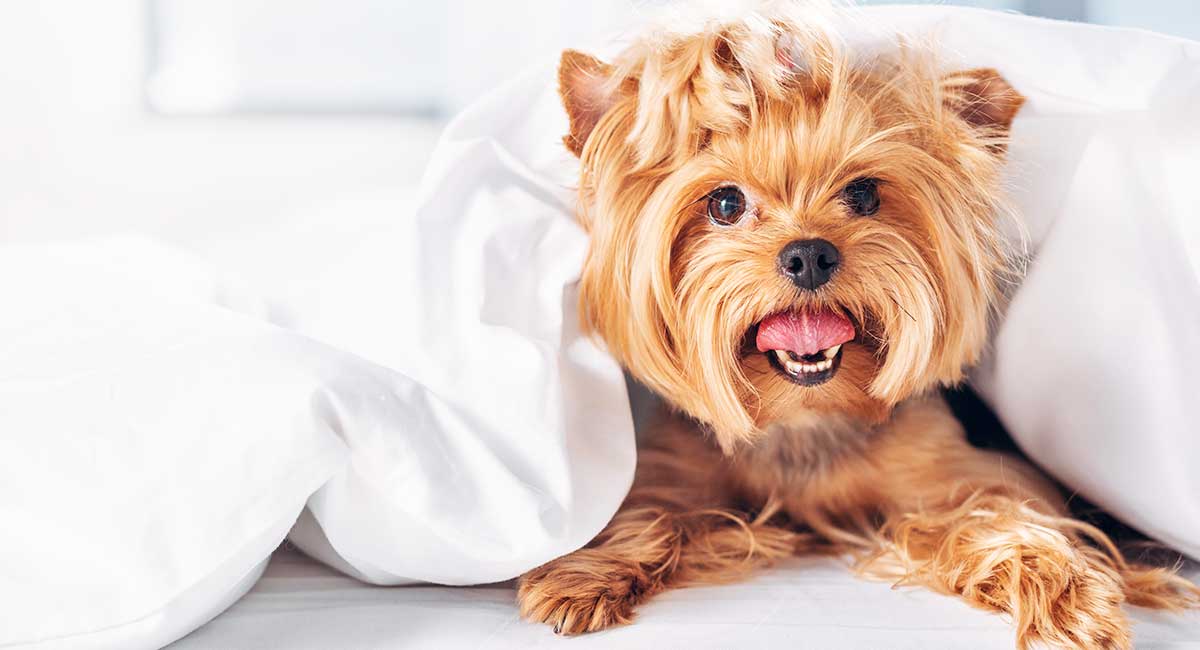
Yorkie Temperament
Yorkie dogs are terriers. This means that they are normally bold, confident, and stubborn. They also have a high prey drive because they were originally bred to work in vermin control. As a result, they tend to not want to make friends with other small pets.
Yorkies are small in stature but this isn’t something that they are aware of. They will face larger animals with the same tenacity as they would rats and mice. They are also naturally suspicious of strangers. So, early socialization to both people and other animals is very important. Despite the bravado with strangers and other animals, most Yorkies are loving and loyal to their closest family members.
Barking
Another hang-up that Yorkies bring with them from their hunting Terrier roots is barking. Terriers were bred with a preference for those that barked. It helped to alert their handlers to find them.
There are some training techniques that may help minimize this tendency if this is not a quality you are looking for in your new pet. But, if barking is something you’d rather avoid, it may be best to choose a different dog breed.
Training
It is important to start both training and socialization early. Waiting to start can increase the typical terrier stubborn streak. Yorkshire Terriers are eager to please dogs and respond well to positive training techniques and praise. They are also smart dogs that can pick up new tricks very quickly. Get them used to meeting new faces from the start as Terriers tend to be wary of strangers. For example, take your puppy out to the park and have different friends over to your house.
When it comes to Yorkie barking, you can try to minimize this habit by how you respond to their barking. Dogs bark more when they learn that making a noise gets results. So, you can help reduce your puppy’s barking tendencies by ignoring them when they bark and praising them when they are quiet.
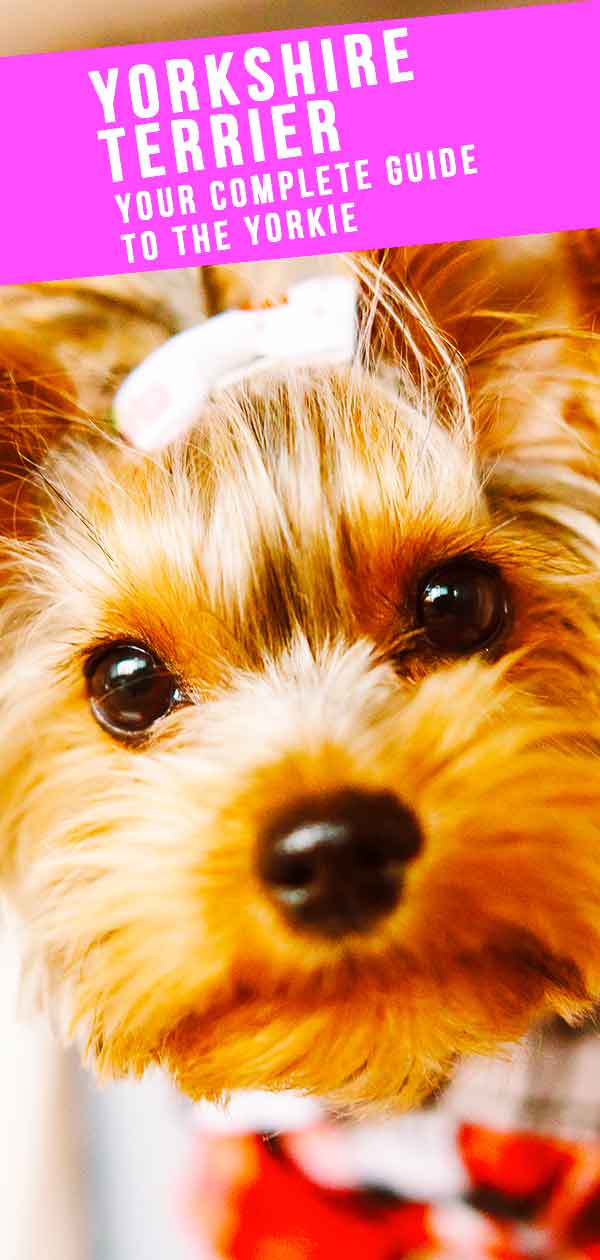
Exercise Needs
Yorkies still need to exercise a lot even though they are small and considered lap dogs. Not just to keep them fit, but to stop them from getting bored. They require a couple of short walks a day as an adult or a few fifteen-minute play sessions in the backyard. Yorkshire Terriers are bright little dogs and can be taught to enjoy retrieving games like fetch.
They tend to do well in canine sports like rally and agility. These sports activities along with puppy obedience classes can be a great way to train, exercise, and socialize your puppy at the same time. Traditional walks are fine for healthy Yorkshire Terriers. However, it is best if you build up the distance gradually. Just be sure that they are not getting overtired keeping up with your long legs!
Yorkie Health
The following are some health issues which you will need to be aware of. Some are specifically associated with their small size. Yorkie health risks to be aware of include heart problems, eye issues, joint disorders and other conditions connected to their small size like hypoglycemia and tracheal collapse.
Dogs can also have allergies just like humans, and skin allergies are common in Yorkies. They can also have issues related to dental disease due to overcrowding, but regular brushing can help keep it under control.
The Yorkie lifespan is pretty good in general at between 12 and 16 years.
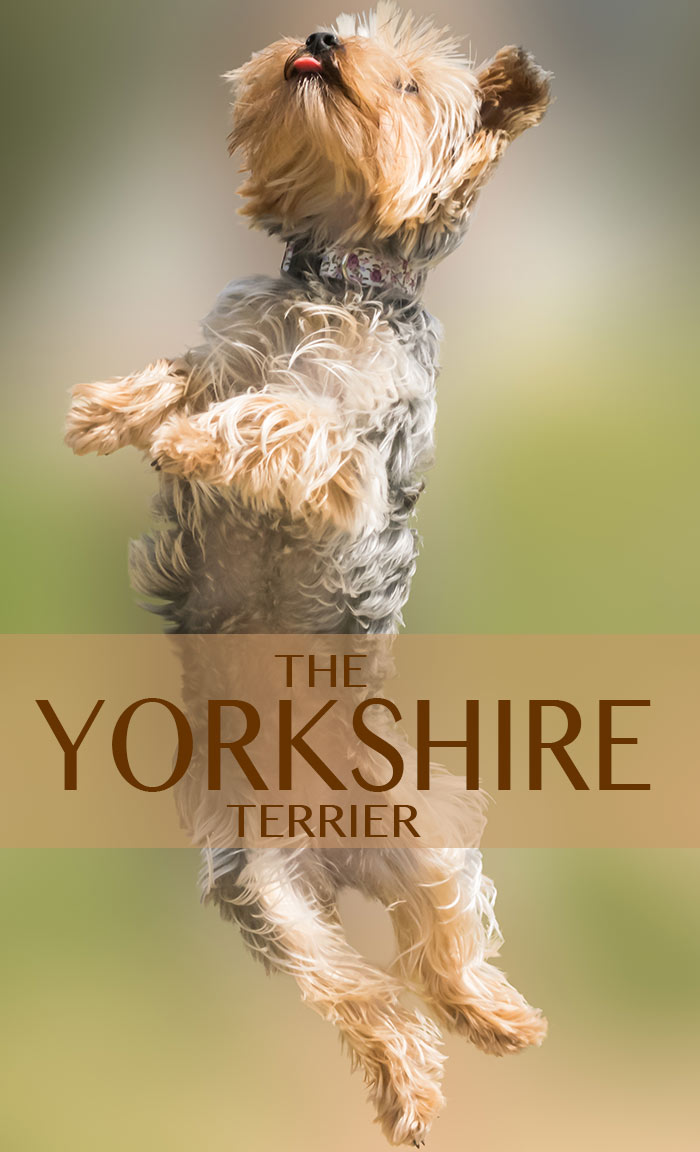
Yorkie Puppies
The best way to find a happy, healthy Yorkshire Terrier pup is by researching a reputable breeder. A good breeder will conduct thorough health checks on their dogs. Plus, they should provide a clean and loving home for both the parents and pups.
Breeders should be happy to answer all your questions and will likely have a few questions of their own to ensure their puppy is going to an appropriate home. You can use our puppy search guide for more help.
Pet stores, online ads, and puppy mills tend to supply unethically bred dogs. They purely produce to meet the demand for popular purebred dogs. These dogs are often unhealthy and poorly treated. It is best to avoid purchasing your pup from any of these scenarios.
Yorkshire Terriers are small but the cost of puppies can be pretty big. In general, puppies can cost anywhere from $1800 to over $3500. Show puppies will usually cost a lot more than those bred as family pets. But, prices will also vary depending on where you live and the current demand.
Remember that this is only the initial cost. On top of this, Yorkies need good quality food, regular trips to the groomers, plenty of toys, and of course routine health checks and vaccinations.
Considering A Shelter Dog
Yorkshire Terrier adoption of a rescue Yorkie is a fantastic way to bring a new pet into your family. It can be cheaper than buying a purebred from a breeder and previously housed dogs can sometimes come already trained. Work closely with Yorkshire Terrier adoption center staff to ensure that the dog you select will be the right fit for your home.
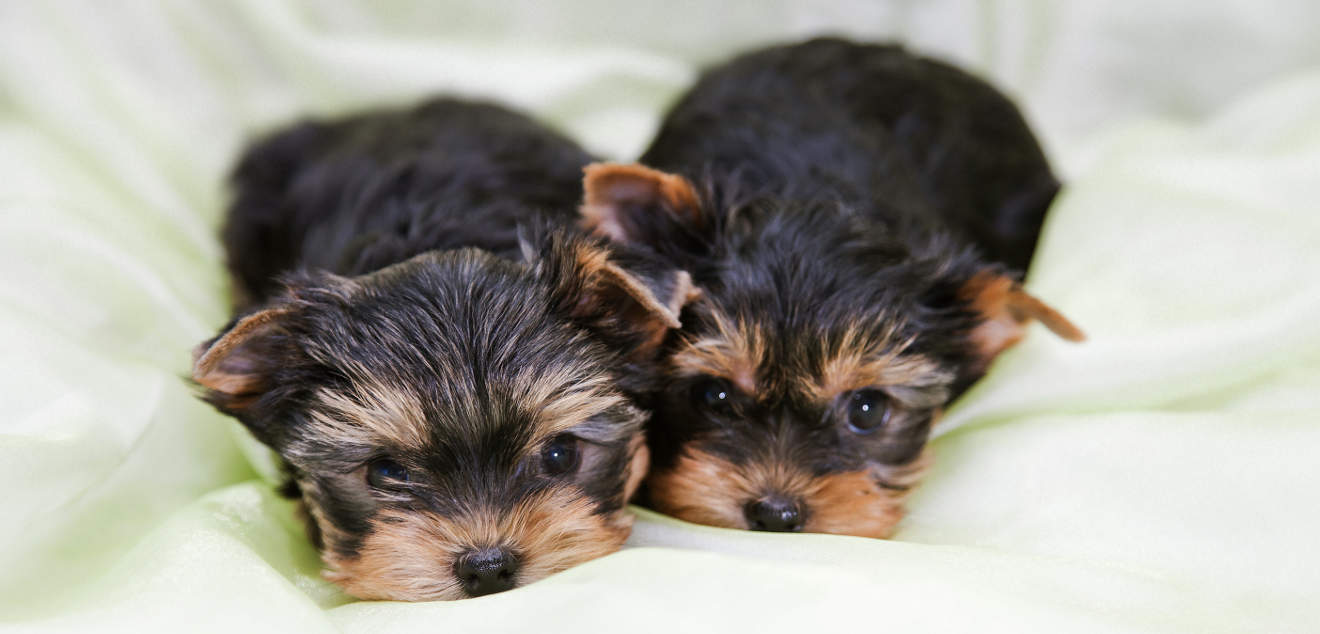

Rosemary Eckstein says
Live in Idaho winters are very cold please give me advise how to potty train him in the house
Donna Baker says
I have a wonder and sweet yorkie named Emmi Rose. I mmm got her at 6 1/2 weeks old because I know the things to look out for in yorkie puppies. Yes, she is very loving and she’s also very hard headed. I had no trouble potty training her. There’s several ways this can be done. For me, since she was only 1.6 lbs when I got her, she had a playpen with her water and food bowls, bed and her potty pad in it. This is still her “safe” place and she is also fed there and goes potty. I keep her water in there also. I have found that the trick to training a yorkie to do anything is to use lots of patience, give lots of praise (even when they potty on the pad) that sometimes you feel like a crazy yorkie parent.
Out of four yorkies that have owned me, yes you heard me right, she is the only one who had a problem eating poo. So, every time I saw her poo, I would clap and praise her with an energetic voice and tell her “Don’t touch it.” If she put her nose on it, I would look sad and say, “Oh no, you touched it, no treat.” If she didn’t touch, then I kept the same enthusiasm and said “ Yea, no touch! Now you get a treat!” She got her treat after I removed the poo.
You can also use a potty pad and when they get used to the pad, then move it a little closer to the door where you will be taking them out. Eventually getting the pad in the grass.
My girl is now almost 3 years old and she still has the comfort of her house (playpen) when she wants it. She’s only 4.5 lbs and doesn’t potty outside because of the hawks that are in our area. They can pick up anything up to 6 lbs. She is allowed on the porch with me and we go for stroller rides.
Also, I recommend using treats that are healthy, like small slices of carrots or raw green beans. I learned that green beans are the only treat for diabetic dogs. This is why I introduced veggies at an early age. And I have home cooked for her most of her life. She is healthy and has never had a sick visit to the vet. I’m also looking into a holistic remedy for fleas and ticks as her brother, who is a chow chow, goes outside. I guess I’m overprotective of my baby, but she’s my world and goes everywhere with me as she’s my service baby.
Rick wydeck says
I have a Yorkie and Chihuahua mix. He is a man dog but health wise is not good. He has seizures twice a month was born in 2012 or 2013 I don’t know what the dog years are it seems to get hard on him scared and shakes plus he has attitude problems.his name is maxx Help
Phyllis Leedy says
whats a good flea tick treatment for yorkies
Lexi says
Bella is so much fun.
Bella is so cute.
Lexi says
Bella is so cute.
Lexi says
I have yorkie.her name is Bella.i love her so much.
She is 8.
Theresa says
Several months ago I purchased a Yorkshire Terrier and named her Abigail Grace. She is an absolute Delight. We have three play sessions a day which keeps her mentally and physically fit an active. A bored dog is a dog that trouble will find. My little girl is extremely well-behaved is already housebroken and greets me first thing every morning and it is such a delight to wake up to her. She has a kind heart and has not gotten into any mischief. I cannot get over how quickly she retains what I teach her. My little girl is only four and a half pounds and is almost 7 months old. So she is one of the little ones but they learn to stay out from under your feet very quickly. It is important that you always take the lead meaning you are the alpha of the house. A Yorkie has a very strong personality, is loyal, and is a big dog and little dog body and will protect you as though he was a Rottweiler. I recommend these wonderful dogs to anyone that has the time to put in to form a bond that will last a lifetime. If you do not oh, it would be a terrible thing to have a Yorkie that has no one to be with the majority of the day. These dogs need someone most all the time. No more than 3 or 4 hours is suggested for them not to have someone to be with. I Now understand why and it makes a lot of sense. So if you are working a full-time job away from the house, one of these dogs is not for you. If you love these dogs I would recommend getting two or three if you are not at home. At least they would have each other.
Sabrina says
Your comment was so helpful. We just bought a 9 week old Yorkshire Terrier. I had no idea that Yorkies needed this much attention or have stubborn tendencies. Our Daisy suffers from separation anxiety and is said to be too young to begin house training. My children are older, ages 13 and 17 but we are still a busy family. At least 4 people I know gave away their Yorkies because they could not get them house trained and they required so much attention. If you could share a few things you did to help your precious Abigail get house trainined, I would appreciate it.
Mona says
Thanks very much for this informative article about Yorkshire Terriers. I have recently adopted a two years old Yorkshire Terrier. She is a lovely dog and is very well behaved. I will continue to check your website for additional information on how to take care of her.
Thanks
Mona